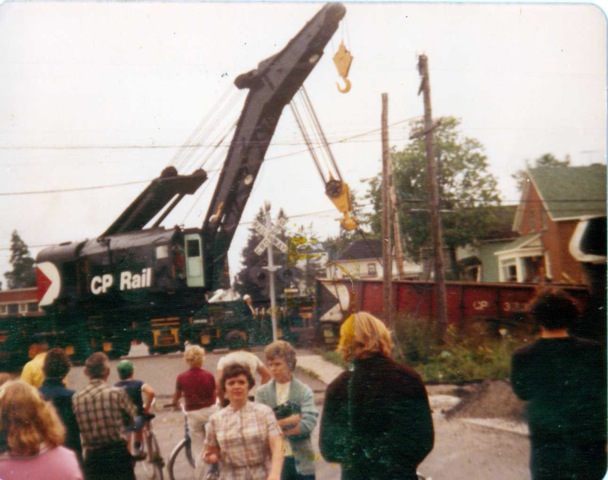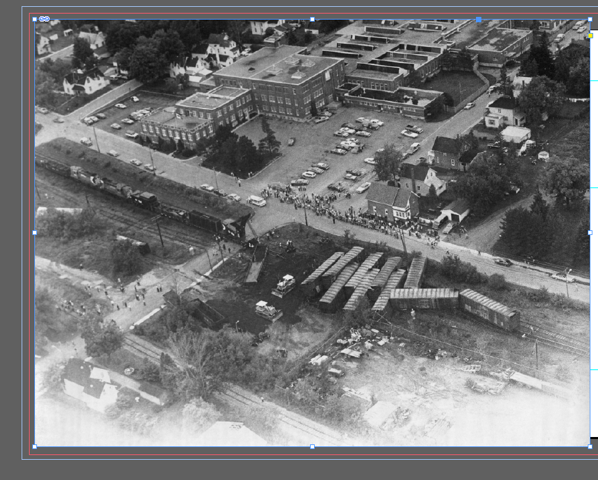Details of Railway Accidents in the Ottawa Area

6 September 1981 - CPR Train 482 Derails 14 Cars in the Centre of Arnprior
 From Andrew Jeanes 15 January 2014 The attached photos show a CP wreck that took place in Arnprior on
Sunday, September 6, 1981. The Ottawa Citizen identified the train as
No. 482, headed to Montreal from western Canada with 115 cars. Fourteen
of those cars derailed opposite the Kenwood Mills plant, right in the
middle of town. The wreck was being blamed on an overheated bearing,
according to a CP spokesman cited by the Citizen. The derailed cars
carried sides of beef, soft drinks, frozen fruit and vegetables, steel,
coal and other general merchandise. Ottawa Citizen Tuesday, September 8, 1981 Train Jumps Track http://news.google.com/(This
is the Valley Edition front page, note that the story also appeared on
the front page of the Capital Edition and the Final Edition (see below). The
aerial photo comes via Bruce Chapman, but was found by Brian Hanington,
who is working on a book on the history of Arnprior. The ground-level
photo comes via the Arnprior 150th anniversary page on Facebook and was
uploaded on May 31, 2012 by Anthony Fletcher, credited to his father
Grant. The
two photos appear to have been taken at close to the same time, based
on the location and position of the crane, which Anthony Fletcher says
is the Montreal Auxiliary but Bruce says is the Smiths Falls auxiliary.
Either way, it's at the east end of the wreck, with the Sudbury
auxiliary likely out of view at the west end.
From the Ottawa Citizen 8 September 1981 Hot box claimed in tran derailment By Dave Mullington and Michael Prentice Citizen staff writers ARNPRIOR An overheated bearing, better known as a "hot box," caused a CP freight train to jump the rails and narrowly miss plowing into homes in the centre of Arnprior Sunday night, a spokesman for CP Rail said today. Several box-cars stopped only 25 metres (75 feet) from the homes after the derailment that left 14 freight cars in a tangled heap. The mangled cars contained no chemicals or explosives, and no one was hurt. CP Rail spokesman Stephen Morris confirmed today the crash was caused by a hot box. A hot box caused the 1979 derailment of a freight train in Mis-sissauga that led to the evacuation of 250,000 persons because of the danger of deadly chlorine gas. The Arnprior train was carrying general merchandise such as canned goods and meat. Since the Missssauga incident, a federal commission of inquiry has recommended improved safety measures to prevent hot-box derailments but the Canadian Transport Commission has not yet acted on the recommendations. A hot box occurs when a wheel bearing overheats, causing the rail car axle to seize or burn off. The improved safety system would require hot-box detectors evey 32 kilometres (20 miles) on track through urban areas. There are no hot-box detectors on the section of track where Sunday's crash occurred, Morris said. He added that CP Rail is planning to put thiem in by next year. Therese Giroux, a spokesman for the Canadian Transport Commission, said today the commission will decide very scon whether to make the detectors mandatory on all rail lines through urban areas. Arnprior Police Chief Dave Thorn ordered barricades immediately after the accident, but no one in this town of 6,100 was evacuated. Morris said damage was minimal to the cars. The rail line was reopened at 7.30 a.m. today. The derailment occurred at the corner of Edward Street North and William Street West in a residential section about two blocks from the downtown business section. Morris said the accident happened shortly after 9 p.m. as the Montreal-bound CP Rail train No. 482 was moving through the town "at under 30 miles per hour." Arnprior Mayor Tom Sullivan said, "It's inevitable it's going to happen. Trains have been running up and down this line here for many, many years. We've all thought since the Mississauga episode we should have a disaster plan, but how do you plan for this kind of accident?" He said the town had a disaster plan and "it looks to me as if our plans worked Sunday night." The 14 derailed cars were part of a 115-car general commodity train travelling from western Canada, Morris said. He said the 14 cars were located near the front of the train and contained products such as soft drinks, steel, frozen fruit and vegetables, tins of meat, coal and sides of beef. The train also included cars carrying listed dangerous products such as ink and cleaning solutions, but these cars were not affected by the accident. "Almost half the town was out during the night to see it," said 80-year-old Genevieve Daze, who lives with her 83-year-old cousin May near the scene of the accident. "There were greater vibrations than ever before," said Daze, who has lived in her Edward Street house for 65 years. Thorn said he was told of the derailment shortly after 9 and went to the scene immediately. Barricades were set up to keep the public back, he said, but nobody was evacuated because by that time the danger seemed to have passed. From the Ottawa Citizen 9 September 1981 Arnprior derailment cleared enough to reopen traffic By Jennifer Jackson Citizen staff writer Trains are back on the track in Arnprior after a 14-car derailment Sunday. But workers are still struggling to clear up the mess. "I believe it will take the rest of the week to clean up the box cars," Arnprior Mayor Tom Sullivan said Tuesday. "They're demolishing the cars and cutting them up for scrap." The 115-car CP freight train was bound for Montreal from Western Canada when it jumped the rails and narrowly missed several homes in central Arnprior about 9 p.m. There were no injuries and no dangerous goods were aboard. Sullivan said one of the cars carried sides of beef that "looked pretty inviting" and frozen strawberries and raspberries, but the area was well patrolled and there was no looting. An overheated bearing, called a "hot box," caused the derailment, CP Rail officials said Tuesday. A hot box occurs when a wheel bearing overheats, causing the rail car axle to seize or burn off. A hot box caused the 1979 derailment of a freight train in Mississauga that led to the evacuation of 250,000 residents from the threat of deadly chlorine gas. Since that accident, a federal commission of inquiry has recommended improved safety measures that would require hot-box detectors every 32 kilometres or 20 miles of track. But there are no hot-box detectors on the section of track where Sunday's crash occurred. Therese Giroux, a spokesman for the Canadian Transport Commission, said the commission will decide very soon whether to make the detectors mandatory on all rail lines through urban areas. |

Updated 14 April 2019

